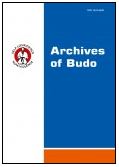2020, Volume 16
Lower-body strength, power and flexibility in karateka: implications for musculoskeletal health
Ina Shaw1, Damien Schwartzel2, Lourens Millard1, Gerrit Jan Breukelman1, Brandon Stuwart Shaw1
1Human Movement Science, University of Zululand, Richards Bay, South Africa
2Human Movement Science, Tshwane University of Technology, Pretoria, South Africa
Author for correspondence: Lourens Millard; Human Movement Science, University of Zululand, Richards Bay, South Africa; email: MillardL@unizulu.ac.za
Full text
Abstract
Background and Study Aim: Karate training has a long history of improving general health and wellbeing, however, little or no research has been undertaken to determine the effect of karate training on muscular fitness, lower-body strength, power and flexibility. The aim of this study was to enhance the knowledge about lower-body strength, power and flexibility of karate athletes of different levels of training and not trainees.
Material and Methods: The study assessed lower-body isokinetic quadriceps and hamstring strength and power, and hip and knee flexibility in a group of elite karate athletes (group 1; n = 18), active karate athletes (group 2; n = 18) and active controls not participating in karate (group 3; n = 18).
Results: Physically active individuals not participating in karate have significantly (p≤0.05) increased hip flexion, hip extensor and hip rotation, but not hip abduction flexibility when compared to elite karateka. The elite karateka were found to have superior strength in their quadriceps at 60 and 180°.sec-1 and hamstrings at 60°.sec-1. The elite karateka were also found to have significantly higher quadriceps peak torque values at 60°.sec-1 than the active non-karateka. For power, elite karate athletes were found to have a lower time to peak torque at 60°.sec--1 for their quadriceps when compared to active karate athletes.
Conclusions: The karateka display greater lower-body strength and power that their active counterparts and that the strength benefit is increasingly dependent on the level of karate experience. However, the non-karate athletes displayed improved lower-body flexibility when compared to the karateka, irrespective of level of training. This implies a possible need to supplement karate training with a flexibility-specific training program to more comprehensively improve muscular fitness.
Key words: muscular fitness, martial arts, kata




